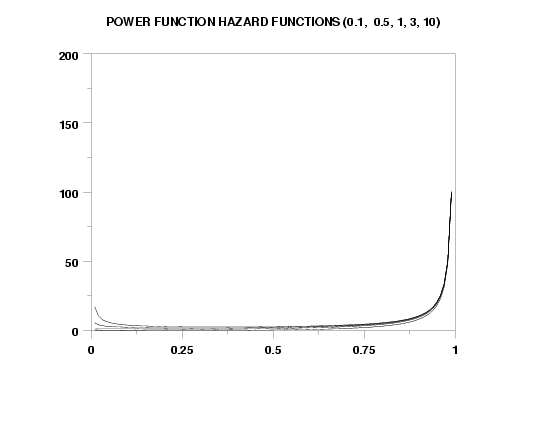

|
POWHAZName:

with c denoting the shape parameter. This distribution can be extended with lower and upper bound parameters. If a and b denote the lower and upper bounds, respectively, then the location and scale parameters are:
scale = b - a The general form of the distribution can then be found by using the relation

If X has a Pareto distribution, then 1/X has a power distribution. The power distribution is also a special case of the beta distribution where the second shape parameter is equal to 1 (the reflected power distribution is the special case of the beta distribution where the first shape parameter = 1).
<SUBSET/EXCEPT/FOR qualification> where <x> is a number, parameter, or variable containing values in the interval (a,b); <y> is a variable or a parameter (depending on what <x> is) where the computed power hazard value is stored; <c> is a positive number, parameter, or variable that specifies the shape parameter; <a> is a number, parameter, or variable that specifies the lower limit; <b> is a number, parameter, or variable that specifies the upper limit; and where the <SUBSET/EXCEPT/FOR qualification> is optional. If <a> and <b> are omitted, they default to 0 and 1, respectively.
LET X2 = POWHAZ(X1,C)
Evans, Hastings, and Peacock (2000), "Statistical Distributions", Third Edition, John Wiley & Sons, chapter 33.
TITLE POWER FUNCTION HAZARD FUNCTIONS (0.1, 0.5, 1, 3, 10)
PLOT POWHAZ(X,0.1) FOR X = 0.01 0.01 1 AND
PLOT POWHAZ(X,0.5) FOR X = 0.01 0.01 1 AND
PLOT POWHAZ(X,1) FOR X = 0.01 0.01 1 AND
PLOT POWHAZ(X,3) FOR X = 0.01 0.01 1 AND
PLOT POWHAZ(X,10) FOR X = 0.01 0.01 1

Date created: 12/17/2007 |